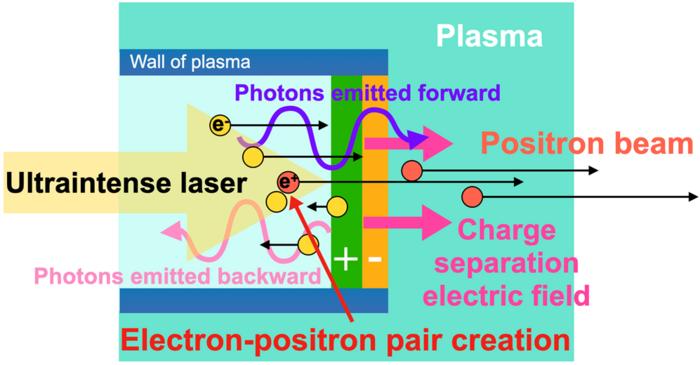As far as quantum physics is concerned, one of the most remarkable predictions is that matter could be produced entirely from light (that is, photons). Pulsars are an example of an astronomical body that can achieve this feat.
 Image of self-organized photon collider driven by an intense laser pulse propagating in a plasma. Image Credit: Yasuhiko Sentoku.
Image of self-organized photon collider driven by an intense laser pulse propagating in a plasma. Image Credit: Yasuhiko Sentoku.
In a study recently reported in the journal Physical Review Letters, a research group headed by scientists at Osaka University has simulated conditions that allow photon–photon collisions, just by making use of lasers.
The easiness of the setup and comfort of implementation at currently available laser intensities make it a hopeful candidate for near-future experimental implementation.
Photon–photon collision has been theorized to be a basic method by which matter is produced in the universe, and it emerges from Einstein’s renowned equation E=mc2. Indeed, scientists have produced matter from light indirectly: by the high-speed acceleration of metal ions like gold into one another.
At such high speeds, every ion is surrounded by photons, and upon grazing past each other, matter and antimatter are produced. But it is hard to produce matter experimentally in modern laboratories via the sole use of laser light due to the extremely high-power lasers needed.
Simulating how this feat may be achieved in a laboratory would be an experimental breakthrough, and thus is what the scientists hoped to achieve.
Our simulations demonstrate that, when interacting with the intense electromagnetic fields of the laser, dense plasma can self-organize to form a photon–photon collider.
Dr. Takashi Sugimoto, Study Lead Author, Osaka University
Sugimoto added, “This collider contains a dense population of gamma rays, ten times denser than the density of electrons in the plasma and whose energy is a million times greater than the energy of the photons in the laser.”
Photon–photon collisions in the collider generate electron–positron pairs, and the positrons are expedited by a plasma electric field that has been made by the laser. This leads to a positron beam.
This is the first simulation of accelerating positrons from the linear Breit–Wheeler process under relativistic conditions. We feel that our proposal is experimentally feasible, and we look forward to real-world implementation.
Alexey Arefiev, Study Co-Author and Professor, University of California, San Diego
Dr Vyacheslav Lukin, a program director at the US National Science Foundation which supported the work, stated, “This research shows a potential way to explore the mysteries of the universe in a laboratory setting. The future possibilities at today’s and tomorrow’s high-power laser facilities just became even more intriguing.”
Applications of this work to the fictional matter–energy conversion technology of Star Trek stay just that: fiction. However, this work could help experimentally verify theories of the composition of the universe, or probably even help find out earlier unknown physics.
Journal Reference:
Sugimoto, K., et al. (2023) Positron Generation and Acceleration in a Self-Organized Photon Collider Enabled by an Ultraintense Laser Pulse. Physical Review Letters. doi.org/10.1103/PhysRevLett.131.065102